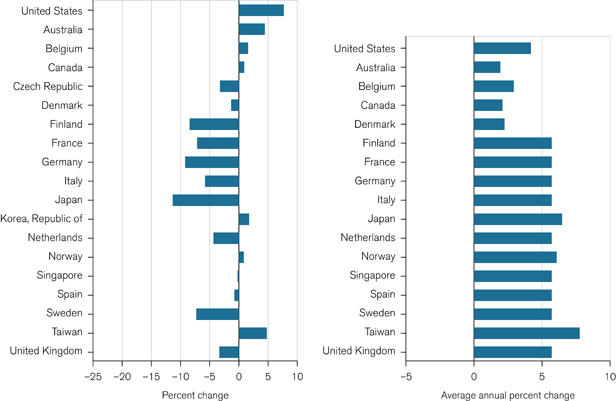Data Show Weaknesses, Strengths in U.S. Manufacturing
As a driving force in the U.S. economy, manufacturing has lost much of its momentum. The dramatic decline in manufacturing jobs over the last decade makes the picture especially bleak.

Source: U.S. Bureau of Labor Statistics; The Information Technology & Innovation Foundation
The decline in manufacturing jobs has coincided with a smaller worldwide role for U.S. manufacturing. Beginning in the late 1980s, China’s share of manufacturing has rapidly and steadily grown. It long ago overtook Japan (which began a slow decline in the late 1990s) and Germany (whose share has held remarkably steady).

Source: United Nations Conference on Trade and Development; ITIF
The United States lags behind its economic rivals in terms of the proportion of its manufacturing output that it exports.

Source: National Association of Manufacturers
When U.S. manufacturing performance is more closely examined, it becomes clear that several trends have been underway for years. As measured against the nation’s GDP, manufacturing has been flat or declining for years, but the decline is worse if the production of computers is taken away. Since the late 1990s, much of the country’s manufacturing growth has been directly attributable to making computers.

Source: ITIF
But the picture changes when you examine the value added in manufacturing, which is the gross output minus the value of the inputs. By this measure, China’s manufacturing sector is rapidly improving, but Germany’s performance has declined in the past decade, while the United States is holding relatively steady.

Source: The Manufacturing Institute
According to the Bureau of Labor Statistics, the United States is among the leading countries in recent years in improving its manufacturing productivity. The first chart below shows the percent change in manufacturing output per hour between 2008 and 2009. The second chart shows the average annual percent change in manufacturing output per hour for the three decades between 1979 and 2009.

Source: U.S. Bureau of Labor Statistics
Perhaps not surprisingly, the American public has a mixed sense of the future of manufacturing. A recent survey by the Manufacturing Institute and the consulting firm Deloitte asked a thousand Americans their views on manufacturing in the United States.
Question one: Percent of respondents who think the U.S. manufacturing industry can effectively compete in global markets.

Source: The Manufacturing Institute; Deloitte
Question two: Manufacturing activity over the next 12 months.

Source: The Manufacturing Institute; Deloitte
Question three: Longer-term outlook for manufacturing sector.

Source: The Manufacturing Institute; Deloitte
Keep Reading
Most Popular
Large language models can do jaw-dropping things. But nobody knows exactly why.
And that's a problem. Figuring it out is one of the biggest scientific puzzles of our time and a crucial step towards controlling more powerful future models.
The problem with plug-in hybrids? Their drivers.
Plug-in hybrids are often sold as a transition to EVs, but new data from Europe shows we’re still underestimating the emissions they produce.
Google DeepMind’s new generative model makes Super Mario–like games from scratch
Genie learns how to control games by watching hours and hours of video. It could help train next-gen robots too.
How scientists traced a mysterious covid case back to six toilets
When wastewater surveillance turns into a hunt for a single infected individual, the ethics get tricky.
Stay connected
Get the latest updates from
MIT Technology Review
Discover special offers, top stories, upcoming events, and more.